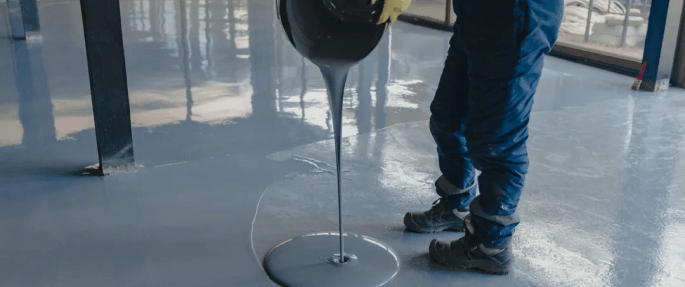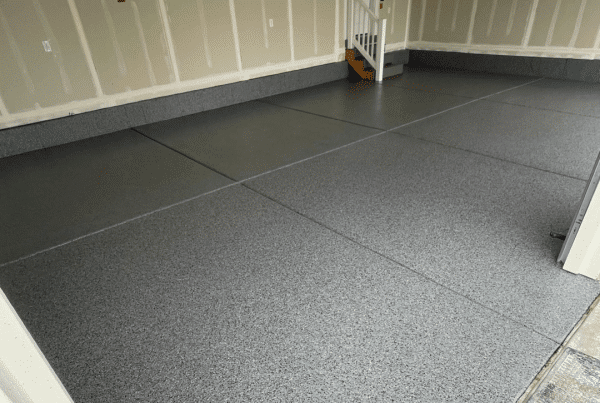Compare Prices on your Epoxy project
Get free epoxy service quotes in minutes and select the best deal!
Epoxy flooring is a hugely popular option for home renovation projects. In fact, it is projected to reach a valuation of USD 4 billion by 2028. Why is epoxy so popular and more in demand than other types of floors? Epoxy coatings are beautiful and can create seamless epoxy floors. In addition, they have strong heat resistance, can easily handle spills, and are highly durable.
Epoxy floors will last a long time if installed correctly. Problems with epoxy floors will emerge if not installed correctly or if the appropriate mixing parameters are not followed. Here are some of the most common reasons for epoxy floor fails and how to avoid them:
1. Improper Surface Preparation Is the First Cause of Epoxy Floor Fails
One of the most common causes of epoxy floor fails is improper surface preparation. If epoxy is applied to an unprepared floor, the epoxy floor will not adhere to the floor properly and will eventually peel up. This misapplication can cause many epoxy floor problems, including trip hazards, safety issues, and aesthetic concerns.
In some cases, failed epoxy floors (especially in public spaces) can even lead to legal action. If someone were to slip and fall on a failed epoxy floor, they could sustain serious injuries. When this happens, homeowners can take legal action against the property owner or manager.
Avoiding epoxy floor fails requires ensuring the concrete surface is in good condition. If any repairs are needed, your installer will ensure they are fixed before applying the epoxy flooring.
-
- First, an epoxy coating will require a clean concrete surface. Your installer will use a diamond grinder, which opens the pores and allows maximum adhesion. This will remove all waxes, oils, grease, and stains. Any dust, dirt, or grease on the surface will prevent the epoxy from adhering properly and can cause it to peel or flake off. After the grinding is completed, your installer will vacuum and mop the floor.
-
- Secondly, once the surface is ready, they will apply the base coat on the first day. The base coat will have an 8-12 hour dry time. Once the base coat is dry, the crew will return the next day to inspect your floor, lightly sand any areas that need attention, and apply the color coat.
-
- The final color coat will have an 8-12 hour drying time. The third day will consist of a clear epoxy top coat.
-
- Applying this topcoat is the fourth and final stage. This gives the floor a textured finish and a layer of protection, which ultimately provides the surface with a polished appearance.
If you have any questions about epoxy flooring, you should consult an expert. They can guide you in selecting the correct product and ensuring its appropriate installation.
2. The Wrong Mix Can Ruin Your Day
Another common cause of epoxy flooring problems is incorrect epoxy mixing. If the epoxy resin and hardener were mixed too quickly, it could create air bubbles in the mix. These bubbles will remain during the application process and can lead to an epoxy floor fail. Another common epoxy floor fail is having the wrong proportions. Epoxy resin and hardener must be in perfect balance with each other. If these two components are mixed with the wrong ratio, the epoxy will not cure correctly, and the epoxy flooring will be susceptible to chipping, blisters, and peeling. The epoxy flooring can become brittle, crack, or delaminate from the substrate. Incorrectly mixed epoxy may also lead to bubbles, divots, and overall epoxy flooring problems.
It’s important to never “hand mix;” always use an electric mixer and the correct mixing paddle. Carefully follow the directions if it says “mix for 5 minutes,” do not rush! The incorrect mixing will lead to an epoxy floor fail.
Another tip: contact a reputable contractor who understands the importance of proper mixing. Otherwise, you may end up with epoxy floor failure.
3. Applying the Correct Primer to Avoid a Failed Floor
Professionals know that one primer doesn’t fit all epoxy flooring systems the same. If you leave out the primer when it is recommended to use one, it can lead to an epoxy floor fail. No primer or the wrong primer can also lead to epoxy flooring problems. Primer is essential because it provides a high-strength bonding layer to the concrete for better adhesion. Mixing the correct mix ratio and the primer correctly is critical to avoid another epoxy floor fail.
4. Failure in Epoxy Floors Due to Moisture Conditions
When installing epoxy flooring, it’s essential to check Moisture Vapor Transmission (MVT) or the moisture emigrating through the concrete. It can move upward through the concrete, creating issues for an epoxy coating or any other floor coating. If moisture is present and is ignored, this is highly likely to lead to an epoxy floor fail. The MVT can produce blistering in the floor after an installation.
Ensure the epoxy flooring properly adheres to the substrate and doesn’t become damaged by the MVT. Many professionals should first test the concrete for moisture and humidity. Based on the moisture meter reading, they will determine if the concrete will need a moisture barrier. If a moisture barrier is necessary, it will protect the floor from having epoxy flooring problems such as peeling or curling away from the concrete.
5. Cure Your Epoxy Properly
The curing process is essential for the epoxy to achieve its optimal strength and durability. If the epoxy is not cured for the recommended length of time, it will be more susceptible to damage and wear. Improperly cured epoxy resin means that the chemical reaction between the resin and hardener failed to occur, thus resulting in typical epoxy floor fails.
A sign of improperly cured epoxy resin is the sticky consistency resulting from erroneous measuring or under-mixing. It is also possible to observe bubbles in the curing resin if the environment is excessively chilly or due to exposure to direct sunlight. When curing your epoxy flooring, it is always a good idea to allow at least seven days for the epoxy floor coating to finish curing at temperatures of 77 ℉ or higher if possible. It is also always a best practice to allow at least ten days for the epoxy flooring to completely cure if temperatures are below 77 ℉.
6. Hire a Professional Contractor
Epoxy flooring is an excellent way to protect and shine your concrete floors. However, ensuring the installation is carried out correctly is critical to avoid various common issues.
To recap quickly, here are the four key things to keep in mind to prevent epoxy floor fails:
-
- It doesn’t adhere properly on unclean and unprimed surfaces.
-
- The wrong ratios and mixing resulted in brittle floors.
-
- It is essential to do a moisture reading on your concrete before applying any product to the floors.
-
- Inadequately cured epoxy is prone to staining and fading.
Connecting You with Topnotch Epoxy Contractors You Can Trust
With that in mind, hiring professional contractors with experience installing epoxy floors is essential to avoid epoxy flooring fails. Contactors will understand how to prepare the surface properly and cure the epoxy so that it will last for years. They can also assist you in selecting a high-quality epoxy that is resistant to chemicals and physical damage.
Hiring experienced professionals ensure that your epoxy floor is installed correctly and will last many years. Contact HelloProject and make sure that your epoxy flooring is applied correctly and done by industry professionals.
Compare Prices on your Epoxy project
Get free epoxy service quotes in minutes and select the best deal!



